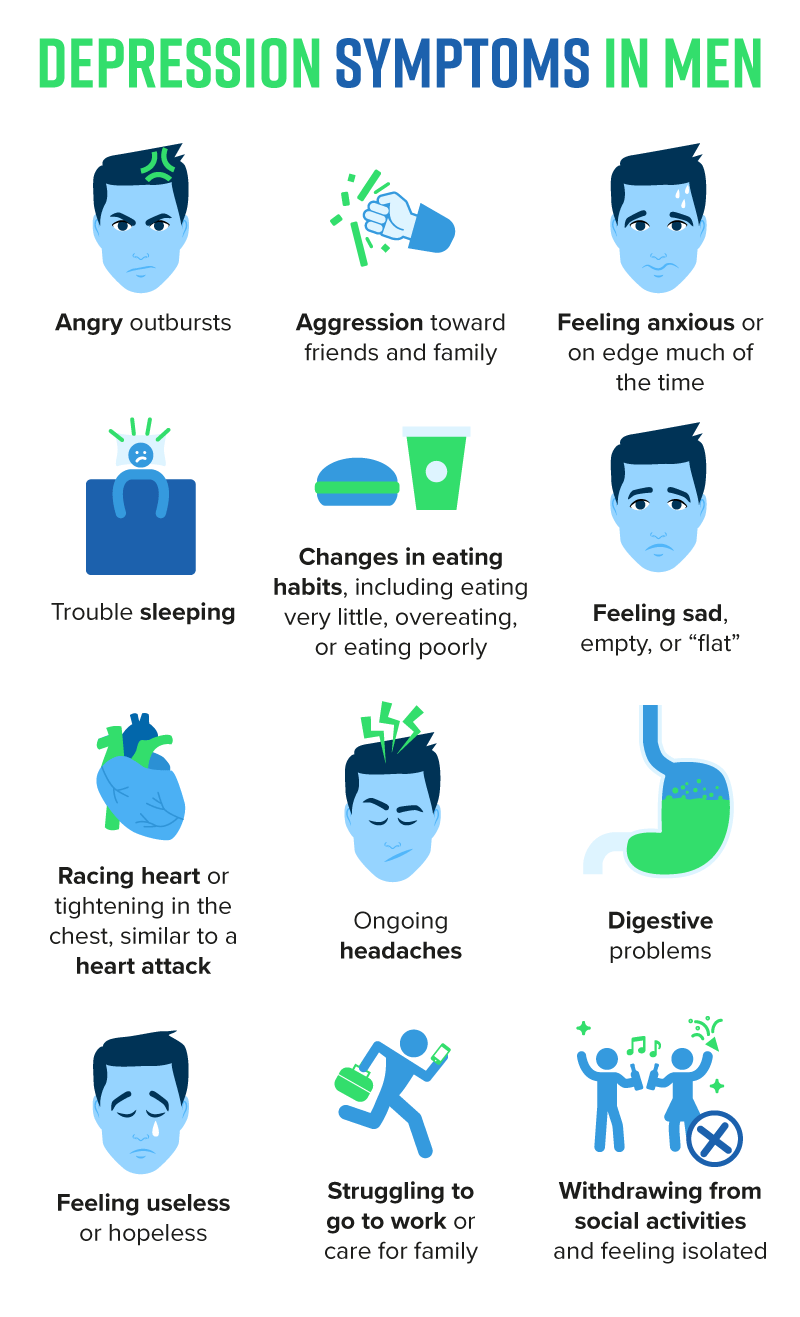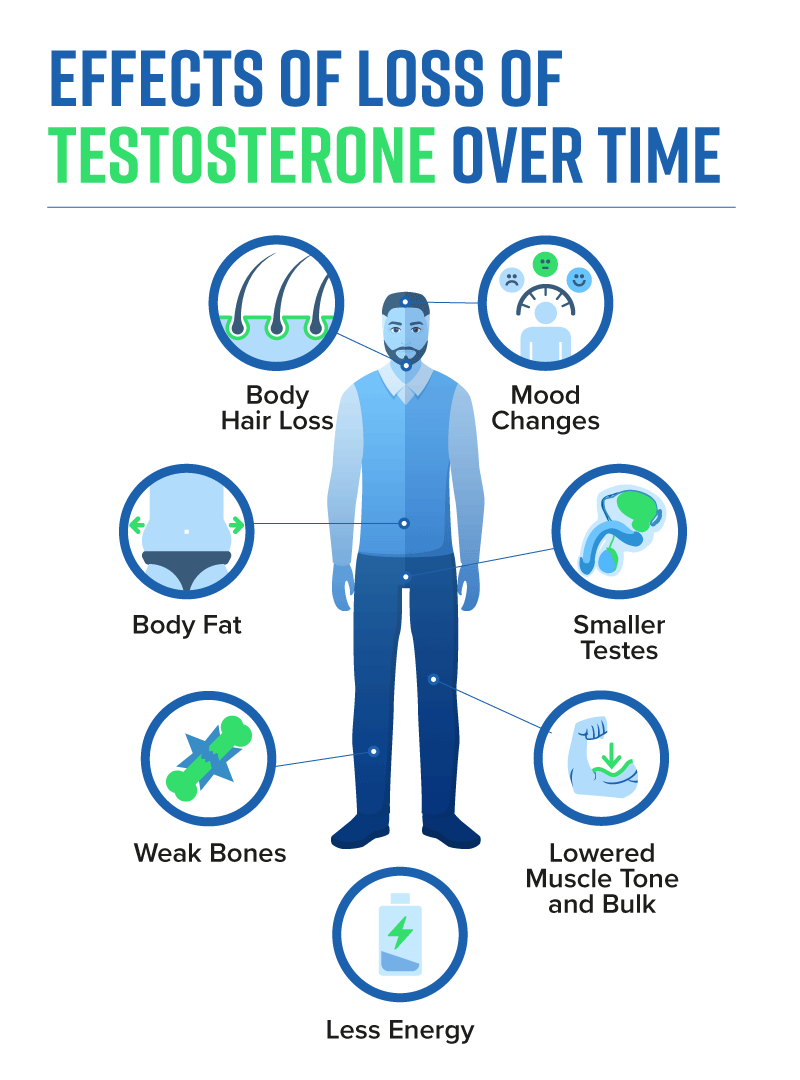Men in the United States tend to pay less attention to their physical and mental health compared to women. (Learn More). They also have more risk factors, like smoking, alcohol abuse, less exercise, higher rates of stress and associated diseases, and lack of insurance coverage, compared to women. (Learn More).
Getting regular health screenings and taking important steps to maintain health will reduce men’s health risks overall. (Learn More).
There are several conditions that men are more at risk for developing, in part due to biological factors and in part due to lifestyle, behavioral, or cultural factors. (Learn More). Preventative medicine is important to managing potential chronic illnesses.
Men’s Health: An Underdiscussed Topic
Most men in the United States pay less attention to their health than women do. Compared to women, men are more likely to smoke cigarettes, drink more than a moderate amount of alcohol, put off checkups and medical care, including mental health care, and make risky behavioral choices. The Centers for Disease Control and Prevention (CDC) reports that 12 percent of men, ages 18 and older, are in “poor health.”
General health concerns tend to affect men more than women, but there are specific aspects of men’s health that also need attention. Understanding these issues can help men make healthy lifestyle changes, get prescreened for potential problems, and understand how scientific advancements help them stay in better shape and live longer.
Risks to Men’s Health in the United States
While genetic and biological factors change specific factors between men’s and women’s health, there are several lifestyle choices and cultural factors in the U.S. that impact men’s health overall. These include:
- Alcohol abuse. More than 30 percent of men had five or more drinks in one day in the past year, which is the CDC’s definition of binge drinking.
- Smoking. Nearly 16 percent of men ages 18 and older smoke cigarettes.
- Exercise. In 2008, only 58 percent of men ages 18 and older met the federal physical health guidelines for aerobic activity.
- Obesity. Among men who are at least 20 years old, 36.6 percent are considered obese.
- Hypertension. About a third of men ages 20 and older meet the criteria for hypertension.
- Lack of insurance coverage. Nearly 12 percent of men under the age of 65 do not have health insurance.
The leading causes of mortality among men include unintentional injuries or accidents, heart disease, and cancer.

Steps Men Can Take to Manage Their Health
- Get screened. Going to the doctor only when something is wrong means you are at risk of developing more serious problems in the long term. At regular checkups, you will be screened for potential problems associated with being male, your family history, or certain behaviors. Increasingly, men are also screened for mental health risks and safety in their living situations.
Most commonly, men are screened for the following issues when they visit their general practitioner: - Certain types of cancer, like colon or prostate cancer
- High blood pressure or high cholesterol
- Diabetes
- Osteoporosis
- Sexually transmitted infections (STIs)
- Hearing and vision loss
- Mental health conditions like depression
- Substance abuse, like smoking
- Get vaccinated. Adults in the U.S. between the ages of 19 and 49, including men, need to stay up to date on certain vaccinations. Many vaccines are administered to children, but some are specifically for adult patients, including booster shots.
These include Tdap, a vaccine that protects against tetanus, diphtheria, and pertussis (whooping cough). It is important to get a booster vaccine every 10 years to ensure your immune system is ready to fight these diseases.
A flu shot every year can help to protect against severe flu outbreaks. Once you reach age 50, you may need additional vaccines, such as those that can provide protection against shingles and pneumonia.
Adolescent boys and young men, starting around age 11 or 12, are recommended to get vaccinated against human papilloma virus (HPV). This virus was first found to cause cervical cancer in women, but it has been associated with an increased risk of genital warts and anal cancer in men. Since the virus is not detectible in men through blood tests or other STI screenings, the vaccine can reduce the risk of contracting the disease.
Common Health Problems in Men in the U.S.
- Cancer: Over 300,000 men in the U.S. lose their lives to cancer every year. The most common types of cancer among men in this country are skin, prostate, lung, and colorectal cancer.
While risks include family history, genetics, and environment, you can lower your risk by mitigating certain behavioral factors.- Quit smoking.
- Stay up to date on screenings for lung cancer, colorectal cancer, and prostate cancer.
- Protect your skin with sunscreen when outdoors.
- Avoid indoor tanning beds.
- Reduce how much alcohol you drink or quit drinking altogether.
- Stay active and maintain a healthy weight.

- Hair loss: This is a common problem among men, and it is often related to genetic predisposition. Losing up to 100 hairs per day is normal, but men who begin to go bald will lose more hair than that.
Common causes of hair loss include the following:- Family history
- Stress from mental or physical issues
- Damage to the hair from pulling it back too tightly
- Age
- Poor diet
- Thyroid disease, including hypothyroidism or hyperthyroidism
- Ringworm on the scalp
- Chemotherapy and radiation for cancer

Slow hair loss, starting with thinning around the hairline, top of the head, and around the forehead, is a common condition in men starting as early as their 30s. Hair loss in these areas will not be noticeable except for more skin exposure. Hair loss in large clumps, or shedding in large amounts, is different from regular pattern balding.
Since there are different potential causes of hair loss, a doctor can diagnose if there is an underlying condition that may benefit from medication. For example, thyroid or testosterone problems can be managed with prescription medications to adjust hormone production. Hair loss caused by genetics can be managed with some medications or even hair transplant surgery.
For the most part, men experience hair loss as a normal part of aging, and thinning hair does not indicate an underlying health problem. However, if you lose a lot of hair at once, experience rapid hair loss early in life, or have other symptoms along with sudden, rapid thinning of your hair, talk to a doctor about potential underlying issues.
- Heart disease: This health risk is common in men, who tend to develop the disease 10 years earlier than women on average. According to the CDC, one in every four male deaths in 2013 was caused by heart disease. This represents 321,000 men in the U.S.
Between 70 and 89 percent of sudden cardiac events occur in men.
Erectile dysfunction may be an early warning sign of heart disease, according to current research. The penis, like the heart, is a vascular organ, and erections can indicate blood flow health. Since the arteries in the penis are smaller than those in the heart, arterial damage will show up there first.
Men in their 40s who develop erectile dysfunction, but have no other factors for heart disease, have been found to run an 80 percent greater risk of developing heart disease in the next 10 years. Men who experience erectile problems consistently over more than a couple months should see their doctor regarding potential heart disease. This can also include screenings for conditions like diabetes, high blood pressure, or excess weight, which may contribute to an increased heart disease risk. Hormonal imbalances like low testosterone can be another risk factor for men’s heart health. Hormonal changes or having low testosterone in general can contribute to increased risk of cancer and diabetes too.
Hormonal imbalances like low testosterone can be another risk factor for men’s heart health. Hormonal changes or having low testosterone in general can contribute to increased risk of cancer and diabetes too.
Men who have higher levels of belly fat, especially if the weight is not evenly distributed, are at greater risk for heart disease. They are also more likely to have low testosterone and metabolic syndrome, which is a condition that includes high blood sugar levels, unhealthy cholesterol levels, and too much weight around the midsection.
Men typically experience higher rates of stress and anger, which can raise blood pressure, heart rate, and stress hormones. This impacts many parts of the body, and it can restrict blood flow to the heart. Two hours after an angry outburst, the risk of heart attack is five times greater, and the risk of stroke is three times higher, according to research.
Consistent stress, which may be associated with mental health problems, can have a long-term harmful impact.

- Low testosterone: The amount of testosterone in men’s bodies varies, but the presence of this hormone is important for overall mental and physical health. It is the primary sex hormone in males, associated with secondary sex characteristics like facial, body, and pubic hair; muscle tone; sex drive; and sperm production, among other important bodily functions.
Testosterone production is controlled by the brain and pituitary gland, which is a small gland at the base of the brain responsible for regulating several hormones. Testosterone is produced in the testes.
Low testosterone is called hypogonadism. It is responsible for:- Lowered sex drive.
- Poor erections.
- Low sperm count.
- Enlarged breasts due to an imbalance with estrogen.
Loss of testosterone over time can cause increased body fat, body hair loss, lowered muscle tone and bulk, mood changes, less energy, smaller testes, and weak bones due to osteoporosis.
There are several potential causes of low testosterone, some of which occur naturally in a man’s life and some of which may be associated with accident or injury. Causes include:
- Testicular cancer, trauma, loss, or removal.
- Radiation and chemotherapy to treat cancer.
- Some medications, like opioid painkillers or hormonal treatments for other disorders.
- Chronic diseases like type 2 diabetes, kidney disease, obesity, liver disease, or HIV/AIDS.
- Genetic conditions like Klinefelter syndrome, hemochromatosis, Kallmann syndrome, Prader-Willi syndrome, and myotonic dystrophy.
- Anabolic steroid abuse.

The amount of testosterone produced by the body also naturally reduces with age, so men older than 60 may need to get regular blood tests to maintain their hormonal health and reduce the risk of some cancers.
Low testosterone is diagnosed by a physical exam, particularly of the genital area, along with blood tests. The doctor will also ask questions about other potential symptoms and major life changes.
Current treatments for low testosterone include gel or patches that go on the skin, injections, tablets that stick to the gums, and oral medications.
- Mental health: Men and women are at equal risk for mental illnesses like depression and anxiety, but men display symptoms of these conditions differently. Men are also less likely to seek help when they experience mental state changes, so diagnosing depression can take longer.
Depression in men may appear as:- Angry outbursts.
- Aggression toward friends and family.
- Feeling anxious or on edge much of the time.
- Trouble sleeping.
- Changes in eating habits, including eating very little, overeating, or eating poorly.
- Feeling sad, empty, or “flat.”
- Racing heart or tightening in the chest, similar to a heart attack.
- Ongoing headaches.
- Digestive problems.
- Feeling useless or hopeless.
- Struggling to go to work or care for family.
- Withdrawing from social activities and feeling isolated.
Men who struggle with depression, anxiety, or other mental health conditions are more likely to drink alcohol, abuse drugs, or die by suicide. Statistically, women are more likely to attempt suicide, but men turn toward more lethal methods, which means their risks are much higher.
Since men are at higher risk of substance abuse, chronic health problems, and death by suicide due to depression, screening for this and other mental health struggles is a crucial part of regular checkups. Antidepressants, talk therapy, and other medical treatments have proven very effective for improving long-term outcomes.
- Osteoporosis: Weak bones can lead to an overall weak skeleton and increase the likelihood of fractures or breaks, which will take longer to heal.
Osteoporosis has been discussed primarily as a disease affecting older women, but men are at risk for this condition too. By ages 65 to 70, men and women lose bone mass at the same rate, with absorption of calcium decreasing in both genders.
Fractures associated with osteoporosis are common in the wrist, spine, and hip. These areas take longer to heal in general. They can greatly impact mobility and quality of life.
There are two basic types of osteoporosis: primary and secondary. Both are associated with age-related bone loss, which may also be called senile osteoporosis. In younger people, the cause of bone loss may not be known, so it is called idiopathic osteoporosis.
In men, bone loss is associated with genetics, as well as certain lifestyle factors like drinking too much, not getting enough exercise, or not eating a healthy diet. There are also underlying diseases or medications associated with bone loss, including gastrointestinal diseases hypogonadism, and glucocorticoid medications, which treat asthma and rheumatoid arthritis.
Blood tests, urine tests, and bone mineral density tests alongside x-rays and a physical exam can help doctors determine if a man has osteoporosis. Doctors may recommend screening for this condition during routine physical exams, depending on age, family history, and lifestyle factors.
Prescription changes can help to reduce the risk of bone loss. Lifestyle changes improve health. In addition, doctors may prescribe a vitamin D and calcium supplement. - Prostate health: The prostate is a walnut-shaped organ unique to the male body, whose primary function is to make the fluid that goes into semen. It can develop several conditions that range from uncomfortable to life-threatening.
For example, benign prostatic hyperplasia (BPH) is a condition in which the prostate becomes enlarged, but it is not cancerous. During puberty, the prostate doubles in size. Then, around age 25, the prostate goes through a second growth phase. This second growth stage can lead to BPH, which can press against the urethra and pinch. The bladder walls may become thicker in response. Eventually, the bladder itself may weaken and not be able to empty completely, which can make BPH more uncomfortable.
BPH symptoms become more obvious in older men, as testosterone levels and overall physical health change. It is the most common prostate problem in men over 50 years old. In 2010, there were an estimated 14 million men with urinary tract symptoms indicating BPH.
There are no real medical treatments for BPH, although eating a healthy diet and maintaining an exercise routine can mitigate symptoms. - Relationship health: Data from the National Health Interview Survey, 2011-2012, found that married men tended to be healthier than cohabiting and unmarried men between the ages of 18 and 64.
In this age group, married men were more likely than unmarried men, both partnered and single, to have had a healthcare visit in the past year. Married men were more likely, regardless of insurance coverage, to get regular health care visits and screenings. They were also more likely to get clinical and preventative services in the past year for reproductive issues, diabetes, cholesterol, and blood pressure.
Men who cohabited with a partner were less likely than other groups of unmarried men to get screenings for health issues. - Reproductive health and sexually transmitted infections (STIs): Reproductive health is as important for men as women, including understanding contraception, understanding screening and treatment for STIs, and managing fertility or infertility issues.
STIs affect both men and women, and they are more likely to be transmitted among people 25 and younger. About one out of every nine men, for example, will contract genital herpes.
Women have several options for hormonal birth control. While these options are not available to men, condom use is strongly recommended to prevent both pregnancy in female partners and the transmission of STIs between partners of any gender.
Men who do not wish to have children may also consider a vasectomy, which is a permanent method of birth control involving clamping or severing the tubes in the vas deferens. This prevents sperm from traveling from the testicles through the penis during ejaculation. Vasectomies are safe, effective, and inexpensive; however, they do not stop STIs.

Regular Screenings and Preventative Treatment Are Crucial for Men’s Health
Scientific advancements have helped to reduce prostate problems, testosterone deficiency, substance abuse rates, and mental health struggles in men in the U.S. Still, the most important step for men is to get regular health screenings, especially for heart disease or cancer that may run in the family.
Lifestyle changes, including better diet and regular exercise, can reduce many risks. Talk to your general practitioner about your personal risks and how to best manage them.
References
Men’s Health. (April 8, 2019). MedlinePlus.
Men’s Health. (January 20, 2017). Centers for Disease Control and Prevention (CDC).
Get Screened. (September 27, 2018). HealthFinder.gov.
Get Shots to Protect Your Health. (January 22, 2019). HealthFinder.gov.
Cancer and Men. (June 5, 2018). Centers for Disease Control and Prevention (CDC).
Hair Loss: Topic Overview. (April 17. 2018). Kaiser Permanente.
Men and Heart Disease Fact Sheet. (August 23, 2017). Centers for Disease Control and Prevention (CDC).
Special Heart Risks for Men. Johns Hopkins Medicine.
Low Testosterone. (May 2018). Hormone Health Network from the Endocrine Society.
Men and Depression. National Institute of Mental Health (NIMH).
Osteoporosis in Men. (October 2018). Bones, National Institute of Arthritis and Musculoskeletal Diseases (NIAMD).
Prostate Enlargement (Benign Prostatic Hyperplasia). (September 2014). National Institute of Diabetes and Digestive and Kidney Diseases (NIDDK).
Marriage, Cohabitation, and Men’s Use of Preventative Health Care Services. (November 6, 2015). Centers for Disease Control and Prevention (CDC).
Sexually Transmitted Infections: Topic Overview. (September 23, 2018). Kaiser Permanente.
Vasectomy: Surgery Overview. (September 26, 2018). Kaiser Permanente.



 Hormonal imbalances like low testosterone can be another risk factor for men’s heart health. Hormonal changes or having low testosterone in general can contribute to increased risk of cancer and diabetes too.
Hormonal imbalances like low testosterone can be another risk factor for men’s heart health. Hormonal changes or having low testosterone in general can contribute to increased risk of cancer and diabetes too.






